SCHUBERTH SRC Review and a SCHUBERTH C3 Redux
The same high-quality SCHUBERTH C3 as always and now with the available SCHUBERTH SRC (SCHUBERTH Rider Communications), a Bluetooth intercom system.
Made by Cardo (Scala Rider), the SRC will fit any C3 helmet.
An SRC system for the C2 and SCHUBERTH Concept helmet will also become available in 2010.
The SCHUBERTH SRC system can communicate with other Scala Rider intercoms.
The SCHUBERTH C3 is considered by many to be the premier flip-up motorcycle helmet.
It’s the latest in a long line of SCHUBERTH flip-ups, going back to the SCHUBERTH Concept and perhaps even further than that.
The Concept was the first SCHUBERTH to pique my interest, but it had a strange internal shape that never quite fit me, and I wasn’t alone, based on a lot of feedback I’ve heard from Concept owners and potential owners.
SCHUBERTH changed all that with the C3, bringing into compliance with the rest of the world in terms of fit.
The C3 is now the flip-up to have. It’s light (for a flip-up); it’s quiet (for any type of helmet); it’s nicely made and now it’s even available in this super-high-visibility yellow color.
Oh, and by the way — the SCHUBERTH SRC Bluetooth communications “collar” is now available for the C3.
And the SRC versions will be released soon to fit the C2 and even the Concept. But you’re not still wearing a Concept, right??
We published a SCHUBERTH C3 “First Look” in August of 2008 when the C3 was first released and then we followed that up with a review of the SCHUBERTH C3 soon after.
The helmet was so good it became the winner of our 2008 Flip-up Motorcycle Helmet of the Year Award, even with one or two minor quality problems that could have been related to the initial manufacturing production run.
Not much has changed on the C3 in the last two years; a good thing indeed.
These helmets have none of the very minor quirks noted in the original; in fact, when the new C3’s arrived, I immediately contacted SCHUBERTH to inquire if these were a completely new design.
The quality of the first C3 helmets was excellent; these latest versions are outstanding. So there must be something to be said for that old saw: “Practice makes perfect”.
Since we’ve already covered the C3 in detail in the 2008 review, first I’ll discuss the SRC Bluetooth communications system, and then recap my thoughts on the C3 based on the latest production versions.
Be sure to refer back to the original webBikeWorld review of the SCHUBERTH C3 for all the details.
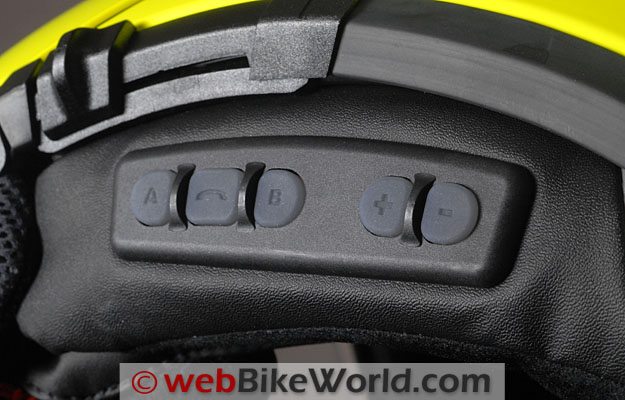
Where to Buy SCHUBERTH SRC Helmet
Check Reviews & Prices on Amazon Check Reviews & Prices On RevZillaSee More Motorcycle Helmets, Motorcycle Visor, Motorcycle Intercom
The SCHUBERTH SRC System
Let’s take a look at the SCHUBERTH SRC Bluetooth communications system.
It is really is an ingenious — albeit expensive — way to add Bluetooth intercom and communications capability to not only the current SCHUBERTH C3, but coming soon for the C2 and Concept.
Of course, we haven’t tried fitting an SRC to the other helmets and SCHUBERTH will release those soon, so we’ll have to take Schuberth’s word for it that fitting an SRC is as easy for those helmets as it is for the C3.
I’ve never been a big fan of the current crop of built-in Bluetooth intercom systems in motorcycle helmets.
The technology is evolving so rapidly that I think it’s better to have a more portable system that can also be re-installed on a new helmet if desired.
Usually by time a helmet manufacturer works out a deal with an intercom supplier, then certifies it and then designs, manufacturers and tests a helmet with that system installed, it’s way past its use-by date.
As a result, most of the built-in systems we’ve seen are crippled in some way or are yesterday’s technology.
This will probably change now that motorcycle Bluetooth intercom systems and their operation and functions are becoming much more standardized, but in any case, the SCHUBERTH SRC system is a clever way to go.
It installs and operates independently of the helmet design — more or less — although I’d have a hard time believing that SCHUBERTH didn’t have the SRC in mind when they designed the SRC collar.
SCHUBERTH helmets have a reputation for low noise levels, and one of the main reasons for this is the careful design of the thick neck roll that blocks a lot of wind, turbulence and noise from entering the helmet.
We’ve noted this for years — holding one’s hand or placing a towel or wind block under the neck of a helmet usually helps to greatly decrease the noise levels.
Careful fitting of this area is crucial, one more reason why it’s so important to find a helmet that fits correctly.
SRC Details
SCHUBERTH cleverly took advantage of their neck roll technology, if that’s what it can be called, by building a Bluetooth communications system into a new replacement neck roll, or collar, that slips right in to the underside of the helmet.
Actually, the system is designed with Cardo, of Scala Rider fame (SRC: could it also mean Scala Rider Communications system?).
And this brings an added benefit — or two actually. First, the SCHUBERTH SRC will communicate with Scala Rider intercom systems.
At least, that’s what SCHUBERTH claims; unfortunately, we no longer have our Scala Rider G4 system to confirm this. But, we have no reason at all to doubt it either.
The other is that the SCHUBERTH SRC system firmware can be upgraded by logging in to the special SCHUBERTH SRC website set up for owners. Like the Cardo Scala Rider G4 system (review), the SRC system is currently available for Windows users only.
The SRC is available as an accessory to fit the C3 and SCHUBERTH says they will release versions for the C2 and Concept. It comes in two sizes; one fits sizes XXS to L and the other fits sizes XL to XXXL.
It costs a rather hefty £299 (about $468.00), which is roughly twice what a “portable” Bluetooth unit will cost. But the benefit is the nearly seamless integration with the C3.
The SRC uses the Cardo spoken status announcements by default (they can be turned off also if desired).
The system gives priority to the cell phone or GPS instructions, then the intercom, then an A2DP audio source, then the built-in FM radio and finally the line-in port if used. It also has VOX and limited multiple system-to-system connectivity functionality.
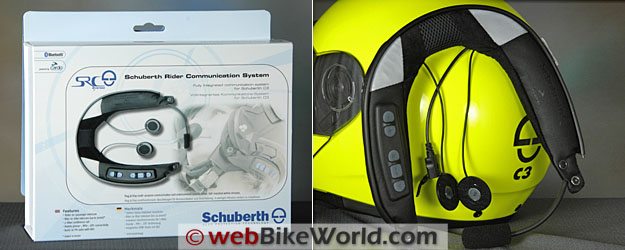
Installing the SCHUBERTH SRC System
The most amazing thing about describing the SRC system is that there isn’t much to describe. It fits the helmet, charge it up, turn it on and it works.
Our Bluetooth intercom reviews used to be all about how to actually get the things to turn on; now there’s not much to describe, because most of those original bugs have long been exorcised. This is definitely a good thing, by the way…
The video embedded below should serve as a better illustration of the functioning of the SRC. The video also details installing the SRC system in the C3.
The SRC system was developed by Cardo, of Scala Rider fame, for Schuberth; I’m sure it had lots of SCHUBERTH input. The ingenious part is the design, which easily replaces the existing collar or removable neck roll that fits the bottom of the C3.
The SRC collar has an embedded heavy-gauge wire around the perimeter that fits under the hard rubber or plastic gasket that surrounds the bottom of the helmet shell.
Simply pull out the back of the collar, then unfasten the front by unbuttoning the metal snap on either side and the stock collar comes out.
Reverse this procedure to install the new SRC system collar, while also carefully placing the speakers in their molded pocket inside the helmet shell, located under the fabric liner.
I’m not sure if the original C3 has the molded speaker pockets and I don’t know how the SRC system for the SCHUBERTH C2 or Concept will fit either.
It’s supposed to be released some time in 2010, so they don’t have much more of the year left.
But speaker installation shouldn’t be a problem in those helmets, because we’ve fitted intercom speakers to many helmets that don’t have molded speaker pockets and never had a problem just slipping them under the fabric.
Once the new SRC collar is installed and the speakers are in place, you’re ready to go.
The system has a large USB port on a wire that can be hidden in between the neck roll layers when riding (we’re kind of surprised that SCHUBERTH didn’t include some type of pocket to stow the cable).
This is used to charge the SRC battery or to connect a wired device, such as an MP3 player or that 45 RPM record player bungeed to the pillion.
It takes about 3-4 hours for the SRC system to obtain the initial charge and when the red lights go out, you’re ready to rock. Again, not much to report here thankfully — this is now-standard motorcycle Bluetooth intercom basics 101.
Press and hold the “Mobile” button (the button with the pictograph of the telephone) to turn on the system. Once it’s on, press and hold again until the lights on the A and B buttons flash rapidly in blue/red and you’re in pairing mode.
Using the SRC
The SRC paired immediately with two cell phones and the other C3 with SRC, along with the trustySony Bluetooth adapter (review) that connects via a jack to an MP3 player and other devices.
I can heartily recommend the Sony BTA and I’m thinking of buying a second just to have as a spare.
It’s tiny and unobtrusive; it never fails; the battery seems to last forever; and it works quickly and seamlessly. An excellent and highly recommended electronic device that can turn just about any other electronic device’s output into a Bluetooth stream for your listening pleasure.
Once the two SRC units are paired, press the A button to communicate.
The mobile button can be used to initiate or answer a call, or if a call comes in (once the SRC is paired with your cell phone), speak (yell) loudly into the microphone and the system will connect.
Calls can be initiated by pressing the mobile button and then speaking into the microphone if your cell phone does voice activated commands.
We found that the stereo system volume is more than adequate, especially in the relatively quiet C3. The quality of the sound isn’t quite as good, even when listening to music. Certainly not audiophile quality, but what intercom system is?
The only real issue with the SRC is the design of the buttons. They’re nearly flush with the surface of the SRC collar, which makes it difficult to select a button when wearing gloves.
But it’s easy to memorize both the buttons and their placement, and feeling for the raised ridges between the buttons will help locate the correct choice.
The SRC system has most or all of the same features as the Scala Rider Q2 (review), with the same FM radio that we still can’t get to work correctly. All we get is static, no matter where we are.
But, since the Bluetooth MP3 player works so well, who needs FM anyway?
SCHUBERTH claims a range of about 300 meters; we measured more like 200 to 225 on an open straight rural road with no other interference. The system is supposed to communicate with other Scala Rider intercoms, but since we don’t have one available, we could not confirm this.
Again, the big news is no news here — five years ago, we’d spill 1,000 words just trying to describe how to use a Bluetooth intercom; today, it’s pretty much a standard procedure that works.
webBikeWorld readers frequently ask us to cut to the chase and name the “best” intercom, but there isn’t one — just like there isn’t a “best” helmet, jacket, gloves or motorcycle. Pretty much any Bluetooth system works well in 2010 and that’s the best news of all.
OK, so let’s take a quick run-through of the features of this latest C3 and be sure to watch the video below also.
Where to Buy SCHUBERTH SRC Helmet
Check Reviews & Prices on Amazon Check Reviews & Prices On RevZillaSee More Motorcycle Helmets, Motorcycle Visor, Motorcycle Intercom
Paint, Graphics and Overall Quality
The C3 hasn’t been revised since our original review of the SCHUBERTH C3, so please refer to that review for all the details. Other than the color, the pair of high-visibility yellow C3’s shown here are identical to the original C3 in our review.
The quality was excellent on the 2008 C3 and it’s just as good and even a touch better on these. We had a slight problem with the fit of the chin curtain in the 2008 version and a gasket misalignment, but no problems at all with these.
The high-visibility paint is nicely applied and has a clear coat finish that isn’t overly thick but should suffice to protect the surface.
The helmet feels solid, especially when the flip-up visor is closed and locked, where the helmet tightens up on the metal locking posts by at least one size.
The liner padding is a bit thin, as it was on the original C3 and there is no liner material on either side of a narrow strip at the top of the head.
The EPS foam is covered with a type of gray flocking, which can get scratched, exposing the foam underneath, so it’s advisable not to throw a set of keys, camera, etc. into the helmet for temporary storage.
I put the video camera in the helmet to carry it because I had to bring both helmets and some other gear, and the camera must have bounced around inside and tore the flocking off the EPS in a couple of places.
Otherwise, everything work and functions as expected, so the C3 still gets high marks for overall quality.
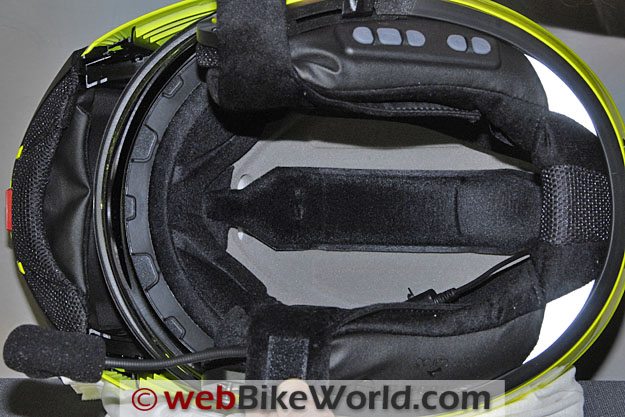
Helmet Fit, Internal Shape, Liner and Comfort
The C3’s fit hasn’t changed. It is a neutral to slightly round internal shape that should fit the majority of riders — except me. I’ll call it a Slight Round for purposes of the webBikeWorld helmets sorted by shape chart.
The same sizing is in order here; the XL has a “60/61” label and the L has a “58/59” label inside.
Since my head measures exactly 60.5, I’m always in between sizes, but lately, due to a shorter haircut and brain shrinkage due to old age, I’ve been going with a size L in most helmets.
The C3 in size L feels loose until I batten down the hatch, when it tightens up enough to make it more like the 59 it is rather than a cheater 60. This, combined with the comparatively thin padding, means there isn’t much room for error.
When SCHUBERTH says “59”, they mean it.
According to the SCHUBERTH size chart, my 60.5 cm head should take the XL.
But the XL uses the next largest shell size, and it’s very noticeably larger, with an additional weight penalty and when the hatch is secured and dogged on that one, the helmet feels about 1 size too big — the 61 that SCHUBERTH correctly says it will fit.
Thus, I’m in between C3 sizes but would much rather wear the size L with its smaller shell size. It feels like a slightly round fit in the upper part of the helmet and slightly narrow on the sides, a fairly neutral fit that should please many riders.
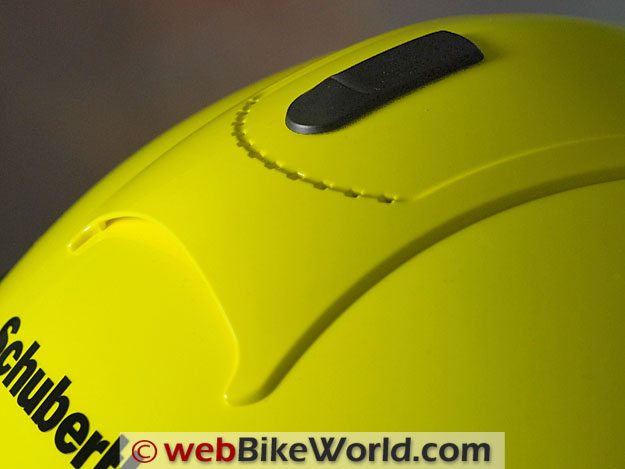
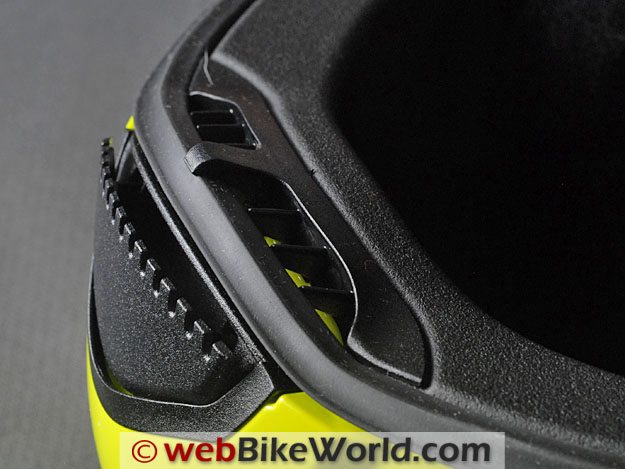
Ventilation and Air Flow
As I mentioned in the original C3 review, the wide and thick neck roll or collar in the C3, along with the very large dual chin curtain, seems to allow the venting system to function more effectively, even without a rear exhaust vent to create negative pressure to pull air through the helmet.
We don’t have the old C3 here for comparison, but reading my notes, I recall that the vent holes through the EPS liner inside the top of the helmet didn’t quite line up correctly, blocking some of the air flow.
No such problem on either of these C3’s, and in fact, it seems as if the liner might have been redesigned slightly. The vent holes allow a good amount of air to flow through the grooves molded into the EPS liner and right over the rider’s head.
This is why there is no fabric on either side at the top; it allows a lot more air to flow directly into the helmet. Thus, this C3 gets good marks for upper ventilation.
In fact, it still has the two fold-down flaps inside that can be used to cover the internal top vent holes in winter to prevent cold air from leaking through, as described in the original review. This time, they may be necessary.
The owner’s manual still warns that the chin vent will provide a low level of ventilation even when it’s closed, which is supposed to prevent CO2 from building up inside the helmet.
It’s still difficult to believe this could ever happen, but you’re protected in any case. The chin vent snaps forward and the cover seemingly blocks most of the air coming in, but it works well nevertheless.
The C3 top vent has been designed to prevent water intrusion when riding in the rain.
The face shield visor has a tiny opening though at either side at the top, and rain can leak down past the gasket and directly into the eye port, but only when you’re stopped or riding at very low speeds.
As soon as the speed picks up, the water doesn’t get a chance to collect along the top of the face shield.
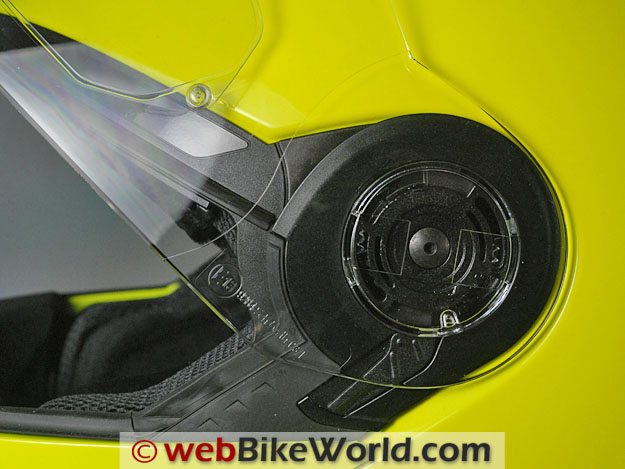
Helmet Weight
The C3 is relatively light for a flip-up; the original C3 without the SRC system weighed 1709 grams for the size XL. The SRC collar weighs about 200 grams — I say “about” because I forgot to weigh it before it was installed.
The size L with the SRC weights 1692 grams (3 lbs, 14-3/8 oz.) while the XL with SRC weighs 1851 grams (4 lbs., 4-1/4 oz.).
This illustrates the difference between the shell sizes and it puts the size L in the neighborhood of the Zeus ZS-2100 B (review) Enduro-style helmet in size XL at 1680 grams.
Also the Bell Sprint (review) in size XL at 1688 grams; the Arai XD (review) dual-sport helmet in size XL at 1693 grams and the Bell Star 2010 (review) in size XL at 1696 grams.
Don’t forget, we’re comparing a C3 with the SRC Bluetooth system and other flip-up helmets in the same or smaller sizes without a complete Bluetooth system, so this is a very good showing.
See the wBW Motorcycle Helmet Weights page for charts comparing the weights of all of the open-face, full-face and flip-up helmets we’ve reviewed.
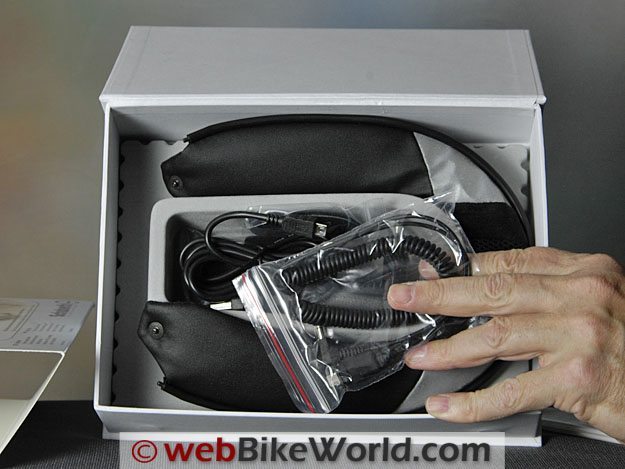
Rotating Visor and Face Shield
The C3’s rotating visor operates smoothly as always, and slams home on these two with no issues. The shell does still feel a bit on the flexy side but tightens up considerably when the door is closed and locked.
The large double chin curtain and the microphone can make closing the flip-up visor slightly more difficult than otherwise; the microphone must be rotated out of the way while the chin curtains are hooked with the thumb while the visor is rotated downwards.
I usually have to push and click both sides simultaneously to make sure everything is closed, then I run my thumb along the inside to make sure the chin curtains are located correctly before buckling up the “quick release” chin strap.
Repeating from the original C3 review, the button that releases the flip-up visor is located under the center of the chin bar. It’s nearly flush and it must be pushed up for the visor to rotate.
The clear face shield has excellent optical qualities. Both of the face shields on the new C3’s measure 2.22 mm thick.
The face shield is very easy to remove by pushing the levers forward on both sides of the helmet simultaneously, which then allow the visor to be rotated all the way back, where it pops out of the side holders.
To replace it, simply push both sides back in and rotate forward. This is illustrated in the video below.
The face shield has 7 detents, with the first two or three feeling weak but the remainder feel stiff. The visor has lifting tabs on both the right and left side, which is very handy.
SCHUBERTH says the first opening is a city setting for defogging, but I wish it was a narrower first setting and I usually just pop the face shield off its click lock and let it rest on top of the chin bar when I need in-town defogging.
I seem to remember the city opening working better on the original C3, but the click lock seems easier to operate on this one, so perhaps there was a minor production change here.
SCHUBERTH also includes a Pinlock anti-fog visor insert (review) with the C3. It’s too warm here yet to take advantage of it, but in other applications, it works beautifully to prevent fogging.
Where to Buy SCHUBERTH SRC Helmet
Check Reviews & Prices on Amazon Check Reviews & Prices On RevZillaSee More Motorcycle Helmets, Motorcycle Visor, Motorcycle Intercom
Internal Sun Visor
The C3 still has the internally rotating sun visor, and I think SCHUBERTH was one of the first to offer this feature. It is operated by a slider on the lower left edge of the helmet, at the bottom of the helmet shell.
The visor rotates very smoothly and these seem to have the correct amount of friction to hold them in place compared to the original C3 we reviewed with it’s slightly loose setting.
The sun visor is still one of the largest found on any helmet and it also functions better than all of them, flip-up or otherwise. It blocks 80% of light transmission, according to the owner’s manual, the EU maximum.
Horizontal peripheral vision of the C3 is as good as always and vertical visibility is average to above average.
Noise Levels
One of the best features of a C3 and other SCHUBERTH helmets is the nicely designed neck roll or collar used at the bottom of the helmet.
This area is probably the number one cause of most helmet noise because it gets a lot of turbulence and the air stream gets funneled between the bottom of the helmet and the rider’s shoulders.
The neck roll on the C3 is a special design, with a very large chin curtain that blends with the wide wind block around the bottom of the helmet to seal most of the space between the rider’s neck and the helmet.
Why other helmet manufacturers don’t pay more attention to this critical area is a mystery.
The SRC system is built into a replacement collar that fits into the bottom of the helmet.
The material and construction is slightly less flexible than the collar that comes with the helmet, and I noticed a slight difference in noise levels with the SRC collar in place, but only because I tried both back-to-back.
SCHUBERTH made some dramatic claims for the C3 about low noise levels when the helmet was announced, and the C3 is still one of the quietest helmets I’ve ever worn, flip-up or full-face.
Again, repeating the original C3 review and worth repeating here: this proves two things.
First, SCHUBERTH has done an outstanding job in both the aerodynamics and noise control with the dual chin curtains and neck curtain; the fit and construction of the liner; and the smooth, narrow and tight-fitting gaps between the rotating visor and the helmet shell.
Second, it demonstrates to other helmet manufacturers that it doesn’t take advanced physics to get it right.
Pay attention to the details and work on that neck roll area, which is the leading cause of helmet noise, and you should be able to get the same results.
Miscellaneous
The C3 uses a “quick release” micro-adjust style chin strap buckle. The chin curtains on either side attach via a section of hook-and-loop in the center that also forms the padding underneath the chin strap.
This makes the chin strap thicker than most, which can cause some interference with thick winter jacket neck lines.
The SCHUBERTH C3 is currently built to meet ECE 22.05 helmet safety standards only but there’s good news U.S. SCHUBERTH fans.
SCHUBERTH has just announced their intention to return to the U.S. market with the full backing of the factory and without relying on a distributor; here’s our news article with more information.
wBW SCHUBERTH Reviews: SCHUBERTH SR1 | SCHUBERTH C3 USA DOT | SCHUBERTH C3 SRC |SCHUBERTH C3 | More
Conclusion
The SCHUBERTH C3 has been made even better, with higher quality in these latest helmets than we remembered in the 2008 version.
And the availability of the SCHUBERTH SRC system is a real plus. The helmet is still very quiet, it’s comfortable, everything works efficiently and it has some unique features.
The SRC system is nicely integrated and other than the nearly flush buttons which are difficult to use when wearing gloves, the system works pretty much like any modern motorcycle Bluetooth communications system.
|
wBW Product Review: SCHUBERTH C3 Motorcycle Helmet With SRC
|
|
|---|---|
| Manufacturer: SCHUBERTH Helme GmbH. | List Price (2010): £474.99-£799.99 |
| Colors: Graphic Black; Metallic Silver; Metallic Anthracite; Plain White; Plain Deep Black; Plain Matte Black, Red and High-Vis Yellow/Green. | Made In: Germany |
| Sizes: XS-XXL Shell Sizes: 2 | Certifications: ECE 22-05 |
|
Rating Scale is subjective: Unacceptable, Poor, Neutral, Very Good, Excellent, Outstanding.
|
|
Where to Buy SCHUBERTH SRC Helmet
Check Reviews & Prices on Amazon Check Reviews & Prices On RevZillaSee More Motorcycle Helmets, Motorcycle Visor, Motorcycle Intercom
Owner Comments and Feedback
See details on submitting comments.
From “K.W.” (July 2011):& “Just returned from a 2 week Colorado “Scenic Byways” The SRC-System worked perfectly (for a day and a half) with a Scala Rider Q2 (great comm system).
After the 2nd day, the SCR-System would not recharge. It would appear the “Micro-connector” to connect the charger is extremely delicate and susceptible to damage whenever used. Robustness was clearly not a design criteria.
In comparison to the Scala Rider Q2, which uses a simple RCA jack, Duh! For the day-and-a-half it did have power, range was limited to 200 m (albeit in rugged mountain terrain). FM radio was also affected by the terrain.
Very disappointed in the recharging connection on the SRC-System. Have yet to hear back from SCHUBERTH on a “fix/warranty” repair.”
From “P.S.” (11/10): “I’d like to offer a few more comments related to SCHUBERTH helmets and the Dallas Motorcycle Show.
AAs another reader mentioned (see “D.J.W.” below), there were lots of smaller sized helmets available for sale at the show but none of the larger (i.e., XXL) sizes. Those sizes must currently be ordered from Europe, apparently.
I tried to buy a size XXL at the show (there were none available), then asked the local Dallas distributor to sell me one from his stock (there are none but smaller sizes in the shipment he received from SCHUBERTH either).
We finally agreed that he would order me one from Europe. He expects to have it in his store soon (in about 2 weeks, or slightly less, with the delay caused in part by his Thanksgiving holiday store closing).
You have printed several interesting size comparison comments from other readers so I thought it might be useful to add one more – which is based on my own head shape.
Just for reference, one of the very few flip-up helmets that fit me at all well is the Shoei Multitec, size XXL. The flip-up that fits me least well of all is the Nolan.
The Shoei “mostly fits,” but even with the thinnest cheek pads available, it still puts a very uncomfortable amount of pressure on my cheekbones. It fits otherwise, but the cheekpad issue is a major detriment to fit and comfort as far as I’m concerned.
That problem notwithstanding, the Multitec has been my primary helmet of choice for several years now simply because I couldn’t find a different helmet that I liked and trusted that fit better than the Multitec.
I tried on a C3 size XXL at the Dallas show and it was one of those “I have found nirvana” moments for me. The fit was perfect in every respect. There were no pressure points and in a word, it felt amazing.
Better still, the silence inside the helmet when the front was latched down was also amazing. I could just barely hear the slightest bit of crowd noise until I flipped the front back up.
I’m really anxious to see how, or if, that showroom silence translates into real world quiet on a motorcycle.
Once I have the helmet in hand and can give it a proper tryout, I’ll let you know how quiet it really is. My experience with the SCHUBERTH does not necessarily support the comment someone made to the effect of “…C3 run one size smaller than a Shoei…”
I think they are sized almost exactly the same, but only if you are comparing the SCHUBERTH C3 to a Shoei Multitec. I believe if you wear an XL in the Multitec, you’ll likely want an XL in the C3 too.
But, as we all know every manufacturer sizes different models “differently.” For example, size XXL in the Shoei Multitec does not fit the same way a size XXL in the Shoei X-11 fits.
You really must try on for size every different helmet brand or model you are considering purchasing before making a buying decision.
Editor’s Note: I’m wondering if the DOT versions of the C3, which will use the DOT headform as described in my recent article comparing DOT and ECE standards, will have an internal shape that is different from the ECE versions of the C3 that we have previously reviewed.
From “D.J.W.” (11/10):& “Interesting tidbit for your wonderful website: I was talking with a SCHUBERTH rep at the Dallas Motorcycle show after asking about the difference between the DOT and Euro C3 helmets.
He indicated that a) the DOT was going to weigh more than the Euro because of an additional layer and the DOT penetration tests b) US will supposedly only warranty and service US SCHUBERTH helmets (boo) and c) something about the US warranty being 5 years vs 2 for the Euro.
The local booth where they were co-located was selling and delivering them at list price, but no XL or larger shell sizes were in the US (except the demo helmets) – they’re “on the way”.
A purely unscientific test with my head says that they run one size smaller than, say a Shoei./p>
Editor’s Reply: Thanks, good info here, I’ll add it to the most recent C3 article. Not surprised the DOT version will be even heavier, due to the penetration tests.
I learned about this also at the Nolan factory tour and will be writing about this issue in my upcoming article comparing the safety standards.
The SCHUBERTH helmets have never really fitted my admittedly odd-shaped round head exactly; the L feels too small and the XL feels too large.
The fit is much better than it used to be on the C2, but still a bit out of the ordinary, so this is definitely a helmet to try before buying.
Not sure if the DOT version will be different — it could be, because the DOT head form is completely different from the head forms used for ECE (as I will demonstrate in the upcoming article!).
BTW, we’re supposed to be getting a DOT version for a review, and I still have an XL ECE version here, so will make a good comparo.
From “S.S.” (9/10): “Just wanted to drop a line on the SCHUBERTH C3 + SRC System. I have had my C3 helmet for about 18 months and I purchased the SRC System back in June. For the most part, they work very well.
The note I wanted to add it that you should mention for Americans purchasing a helmet from (Europe) to make sure and ask that the VAT is removed.
If not, (the retailer) will NOT remove it and it is an extra 17.5% profit for them as it is only suppose to be charged to residents of the UK (or Europe).
For the above reason, I purchased my SRC System from a vendor in Germany who automatically removed the VAT and my shipped price was $323! (for the SRC collar only).”
Editor’s Note: Good tip. Note also that the retailer has to be able to prove that the product was sold outside the EU or VAT district to not charge the VAT, and sometimes, depending upon the product value, they don’t or won’t keep the records on this.
So it always pays to ask about the VAT.
From “F.T.” (9/10): “On my last trip to Turkey, I found a SCHUBERTH dealer and tried on the C3. I had been wanting one for some time but was wary as I was unable (until that time) to try one on due to non availability here in the U.S.
Once I tried it on, I was hooked and bought it on the spot. The fit was amazing and after a Nolan/ X-Lite 1002 (review) and subsequent Nolan N-103 (review) I was convinced that I found the perfect helmet (subjectively speaking, of course).
I get some noise due to the windshield on my Trophy but after a day of riding, I don’t feel like my head was in a pressure cooker. The ventilation is amazing and it was pure simplicity to fit my comm system into it (Starcom1 Advance).
I don’t feel the need for a Bluetooth system and as an iPhone user I learned my lesson with the Nolan N-Com system which was supposedly compatible but only for less than the basic functions.”

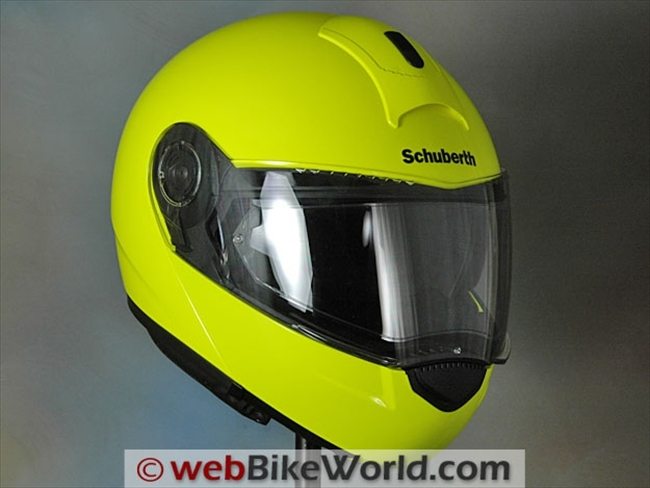


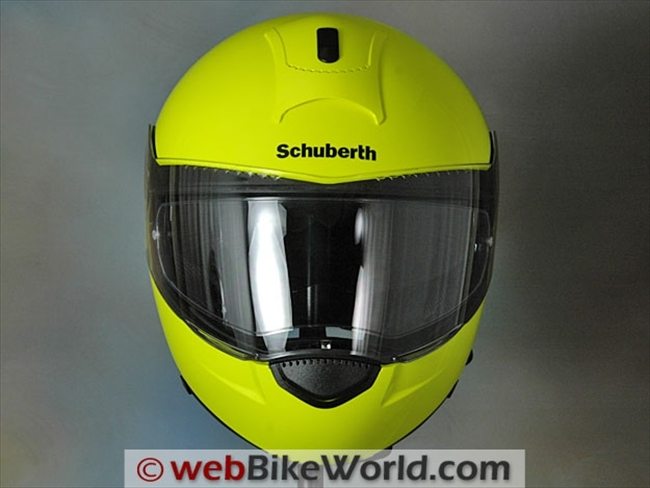


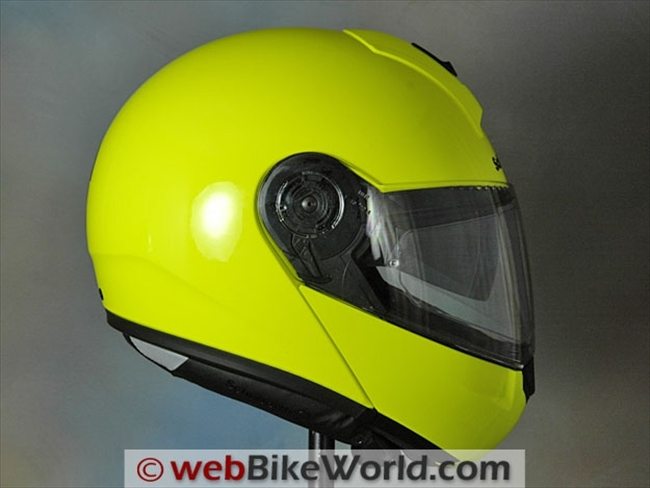

No Comment